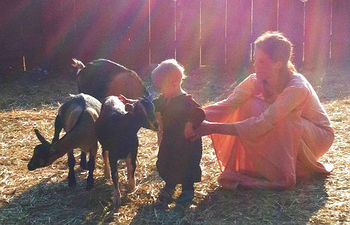Animals enhance our lives in many ways, but physical contact tops the list as being beneficial

Dr. Alexander and her daughter, Snow, petting goats at the Michigan Renaissance Festival
Lyssa Alexander | Contributor
Whenever my young daughter sees an animal, all she can focus on is trying to get close and touch it. This desire is nearly universal in small children, but adults also crave physical contact with animals.
How many times have I been to a butterfly garden and seen a father or grandmother stretch out their hand to make a perch. They leave that perch hovering in the air in perfect stillness just hoping that a butterfly will light upon them for a brief moment. We dole out cash to feed the giraffes, we sit motionless for hours while our cat takes a nap, and we make friends with every dog who greets us at the park.
There is something truly special and powerful about that cross-species connection. I feel it strongly myself. The joy of touching and interacting with animals is a big part of what brought me to veterinary medicine in the first place.
The power of the human-animal connection is quite well established. Numerous studies have found supportive evidence for positive mental and physical health benefits from being near animals and touching them.
One study actually showed an increase in immune function in college students just from having them pet a dog for 18 minutes. Touching animals has been associated with better mood, healthier interpersonal interactions, reduced stress, reduced fear and anxiety and improved cardiovascular health.
There is also some evidence that human-animal interactions positively effect pain management, increase trustworthiness, reduce aggression, enhance empathy and improve learning. The mechanism of all these positive benefits is likely related to oxytocin release, though multiple factors are undoubtedly at play. Regardless of the cause, the outcome is striking.
Most people don’t need the science to know that there are huge benefits from touching animals because they have experienced them first hand. For all of these reasons, there are huge numbers of programs dedicated to facilitating human-animal interactions.
Animals are used in educational programs as well as mental and physical rehabilitation programs throughout the world in many creative ways.
My technician, Janella Poch has taken her beagle Monte to numerous retirement homes, children’s reading programs and mental and health rehabilitation centers for years. He has been certified with Therapy Dog International since 2007 and will be receiving an award for “Outstanding Community Service,” Sept. 26 by the Arc of Lucas County. Getting involved in animal learning and therapy programs can be immensely rewarding for pets and owners as well as for care recipients.

Janella and Monte the Therapy Dog
Lyssa Alexander | Contributor
Despite the numerous benefits from human-animal interactions, there are also dangers that need to be addressed. Though my daughter wants to touch every animal she sees, it is my job to keep her and the animals safe.
Educating children on the proper way to approach and interact with animals is extremely important. Most children are taught to ask before petting people’s dogs, but our education has to go a step farther. Not only do children have to ask owners if they can pet their dogs, but they have to learn how to recognize if they animal doesn’t want to be touched and how to restrain themselves in the face of these signals.
Various organizations, like Doggone Safe and others are dedicated to dog bite prevention through education.
In addition to bite prevention, children must also be taught about hygiene. The CDC estimates that 70,000 people get salmonella from handling reptiles each year.
Adults could use some education on appropriate animal interactions as well. I was slightly surprised at the lack of situational awareness I observed on a recent outing with a friend.
Her small dog has some anxiety around strangers. During a one-hour period of time on a public street, more than a dozen people tried to reach down to touch her dog without asking permission. Many of them even persisted in approaching the dog when asked not to by my friend or when growled at by the dog.
Though I was somewhat taken aback, I can see how strongly people crave that interaction.
There is a large need for human-animal interactions in society. The benefits of these interactions and of pet ownership are undeniable. However, showing restraint and making mature decisions about how to interact with animals is essential. Making sure our contact with animals remains positive is the best way to keep animals a big part of all of our lives.
So, what’s the key to health and happiness? Snuggle a puppy, pet a bearded dragon, feed a goat, wash your hands and think before you act. Congratulations to Janella and Monte and to everyone who work hard to bring animals to peoples’ lives in positive ways.
Lyssa Alexander, DVM is a veterinarian at All Creatures Animal Clinic, and she treats dogs, cats, exotic and pocket pets. You can follow her on Twitter @AllCreaturesAC.


Comments
GregP CRC
Sat, Sep 7, 2013 : 12:58 a.m.
This article could only be written by Dr. Alexander. When my pets come to see her, she has such a strong connection with them. I would have to call it spiritual. I don't trust my pets with anyone other than her and Dr. Lewis from ACAC. I firmly believe my 18 year old cat wouldn't have recovered numerous times from serious illness had the vets and staff at ACAC not respected his strong will to live like I do. My little old Marcel is the poster child for old age health problems, but he's happy and comfortable. PS. Dr. Alexander, Marcel would like you to write an article on the challenges faced by senior citizen cats and how to keep them happy and healthy.
mady
Fri, Sep 6, 2013 : 1:27 p.m.
Lyssa, excellent article. I can attest to the therapeutic good from sharing one's life with a furry body, I was recently divorced and my 6-year-old cat "Esther" has been a wonderful companion! she sleeps on my bed at night, I can pour my heart out to her and know with absolute certainty that anything I tell her will remain confidential(chuckle)!
Connecting Dots
Fri, Sep 6, 2013 : 1:09 p.m.
All this sound well touchy feely loverly, however, some folks do not appreciate a barking dog in the middle of the night...or even in the middle of the day. What may be delightful 'sounds' to the owner may be a disturbing annoyance to the neighbors. Every dog owner should know about 'bark collars'. I always had a dog along with cats and birds when my three grown adult children were young, Our pets never annoyed other people, they were in the house with us. And I certainly wish pet owners were cognizant of the fact that we are not enjoying their pet loose or barking.
BHarding
Sat, Sep 7, 2013 : 7:10 p.m.
I've had dogs for forty years and none were/are barkers. They might bark in the middle of rough-housing, once or twice, but never at strangers or noises or mail carriers. I agree with you, some people with barking dogs just grow deaf to the barking, and don't realize that it is not normal behavior for a dog. It can be trained away fairly easily, if people would just take the time.
Elaine F. Owsley
Fri, Sep 6, 2013 : 11:33 a.m.
Our late chow mix, Sarah Jean, went with me to visit my husband in a local rehab center. After greeting Dad, she pulled me down the hall and into every room to "visit" those occupants. In one, the gentleman couldn't sit up, so his son was describing Sarah. She seemed to understand the situation, went to the head of the bed, stood on her hind legs and made sure the man saw her. The next stop was a blind woman in a wheelchair. As her husband told her about Sarah, Sarah went up to her and placed her head under the woman's hand so she could feel her presence and pet her. It was amazing to everyone watching. Sarah had no training. She was rescued at age 3 from an abusive owner and was my "therapy" dog for almost four years before she passed away.
mady
Fri, Sep 6, 2013 : 1:23 p.m.
Hi Elaine, Good For You for rescuing Sarah Jean!! Good to know that she lived out her life with caring owners!